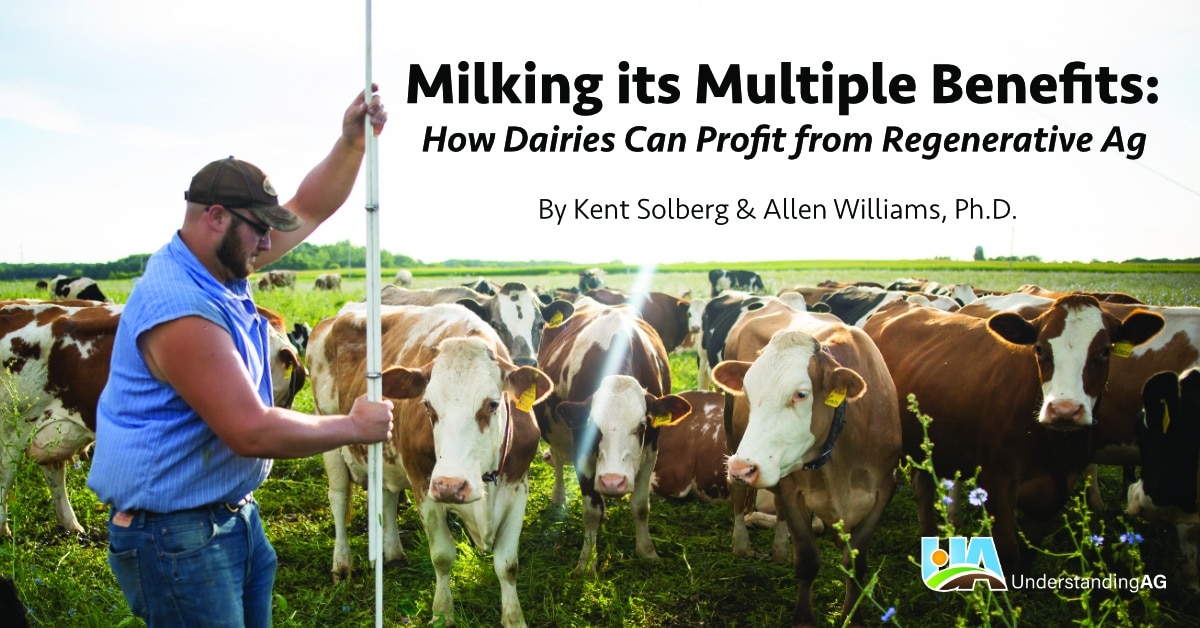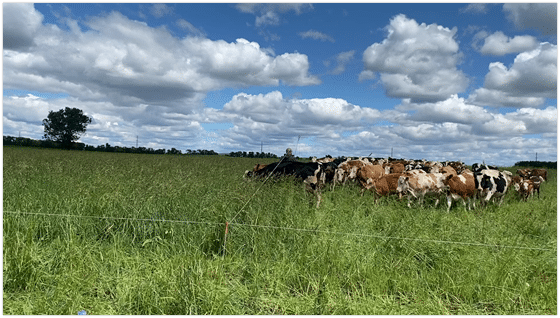
Farmers often ask, “How can my farm benefit from moving to regenerative agriculture?” We most pointedly hear this from dairy farmers. With a seven-day-per-week workload, dairies have developed schedules designed around getting all the chores done. They feel that unless something offers the promise of additional milk or crop/forage yield, they struggle comprehending how to fit a perceived “one more thing” into already tight schedules. Much of this schedule has been driven by applying all the inputs recommended by industry sales representatives. These inputs often promise yield increases. Driven to produce by the fear of not having enough feedstuffs, farms readily build in these inputs. Yet, a move to implement the principles of regenerative agriculture is perceived as “one more thing” they need to do.
Comments from Regenerative Dairies
When we talk with dairies that have moved to regenerative agriculture, the conversation changes. We hear about lower costs of production and greater net profit; reduced input needs; resilience to weather extremes; and renewed enthusiasm for dairy and farming. Over the past several years, we have recorded some of the comments we hear from dairy farms that are moving down the regenerative path. These comments include:
- Better cow health: Lower somatic cell counts, Increased pregnancy rates and pregnancy retention, Increased cow longevity - more total lactations, Reduce veterinary and pharmaceutical expenses
- Better forage quality, leading to lower feed requirement per cow
- Increased milk components.
- Greater forage and pasture biomass production coupled with lower input costs.
- Ability to add cows without increasing acres.
- Grazing heifers look as good or better than pen raised.
- Hooves of grazing heifers look like they were trimmed.
- Grazed heifers are calmer when they freshen compared to pen raised heifers.
- Not having to scrape heifer pens every day (while heifers are out grazing).
- No more field rutting.
- Reduction or elimination of synthetic fertilizer needs.
- Reduction or elimination of herbicides, insecticides and fungicides.
- Field drown-out spots are fewer or non-existent.
- Field work is completed in a timely fashion while neighboring farms are unable to access fields as they are too wet.
- Land planned for pattern tile installation no longer requires tiling.
- The ground is more mellow (less rutting, reduced fuel consumption, reduced labor).
- Using one tractor to do spring field work (after moving to no-till) when three were required in the past under a full tillage program.
- Regretting that they didn’t start down the regenerative path sooner.
Replacement Heifers
Raising replacement heifers is considered the second-highest cost of production for most dairies. Research data and case studies demonstrate that developing heifers through active grazing not only dramatically reduces the cost of rearing those animals, but they often perform better during their first lactation and stay in the milking herd longer.
If cows stay in the milking herd longer, the need for replacements is reduced. Thus, not every heifer born on the farm needs to stay on the farm. This offers the opportunity to develop and market replacement heifers to other dairies as an additional revenue stream.
Selecting animals that fit the regenerative farm will further reduce replacement costs while building a stronger, more resilient herd. This is further enhanced by favorable epigenetic selection. Heifers developed through adaptive grazing are epigenetically superior and will produce offspring that share that favorable epigenetics. With the cost of rearing a heifer at a minimum of $1,600 to over $3,000 before they reach the milking herd, the cost savings can be dramatic.
Because heifers do not need to return to the milking facility 2-3 times per day, they offer the greatest flexibility to integrate livestock into cropping systems through grazing of cover crops – a key principle of regenerative agriculture. Understanding Ag blogs and articles have clearly documented the value of livestock integration in accelerating soil health development, reducing input costs, and building resiliency into farming systems. Does this mean that all dairy heifers need to be grazing during their entire development period? No. Ideally, that would be best, but it is not always feasible. We work with several dairies that actively graze heifers during a 7-9 month grazing season. Some even graze baby calves at their mother’s side or on “nurse cows.” Some northern dairies out-winter heifers six months or older as a standard practice. Adaptive grazing at appropriate stock densities is so biologically powerful that significant benefits are derived with a single day, or less, of grazing impact on any given acre annually.
Why Grazing?
Grazing is often perceived as a “one-more-thing-to-do” chore. Under a well-managed adaptive grazing system, the manager is accomplishing several chores with a single daily task. In addition to feeding livestock, they are spreading manure, checking animals, building soil biology, and enhancing positive ecosystem and epigenetic influence across the soils, forages and animals.
All of these contribute to a positive bottom line. Here’s how:
- Greater soil aggregation (more mellow) creates the opportunity to more efficiently and effectively utilize no-till planting equipment.
- Integrating livestock into complex cover crops is the quickest means of building soil aggregation on crop acres.
- More time grazing leads to less manure handling.
- Less hours on equipment means lower fuel consumption. Before the 2021 planting season, many farms were able to purchase bulk fuel for around $1 per gallon. Current farm fuel costs are around $3 per gallon.
- Parts for farm equipment have risen over 25% since January 1 – if they are even available.
- Synthetic fertilizer costs have more than doubled. Many chemicals have doubled or tripled in price. Grazing can be a management tool to reduce reliance on these more expensive inputs.

Enhanced Resiliency
Implementing the Six Principles of Regenerative Agriculture increases soil carbon levels and improves water and nutrient cycling. This leads to reduced nutrient runoff and leaching (better surface and ground water quality) and reduced need for synthetic fertilizer inputs. This further protects water resources and reduces farmer liability due to runoff.
The resiliency built into regenerative dairy farms permits them to handle weather extremes, commodity price volatility, supply chain disruptions, regulatory changes, inflation and labor shortages better than their conventional counterparts.
Can Any Farm Do This?
We are often asked, “Can this be accomplished on my farm?” The short answer is “Yes.”
Smaller operations (under 300-350 cows) generally have the ability to implement greater change quicker, just as small businesses tend to be more nimble than large corporations. Many dairies this size find that grazing the milking herd is feasible. We fully recognize the logistical challenges of grazing the milking herd of larger dairies. Grazing of heifers is certainly feasible but consider also what can be accomplished with dry cows.
Large dairies have large management teams. Specific team members can be trained to manage the grazing of heifers and/or dry cows. Does this mean more work? No. It is trading one labor for another, more productive and beneficial labor. However, all team members must be on board to facilitate change in operational course and direction. The speed at which a dairy implements change is primarily based on the mindset of the people on that farm.
Regardless of size all dairies can implement a number of regenerative practices within the first year that include:
- Increasing crop plant diversity through the utilization of cover crops, relay cropping (e.g., fall triticale planting following silage corn), increased crop rotation diversity and increased plant diversity in new hay seedings.
- Reducing soil disturbance by altering manure application rates and patterns. Most states allow for reduced-rate applications during the growing season on a living plant (e.g., 3000-4000 gals/acre surface application on recently cut hay ground without incorporation).
- Moving to strip tillage or possibly no-till, depending upon field conditions.
If farm managers are intentional in implementing the Six Principles of Regenerative Agriculture, the benefits we see within 2-3 crop seasons include:
- Shifting the majority of tilled acres to no-till.
- Grazing heifers on cover crops and some hay acreage.
- Reduced manure handling.
- Reduced need to purchase feed supplements.
- Reduced synthetic fertilizer, insecticide and herbicide applications.
Summary
Change is challenging. However, the one constant in our lives is change. Moving a dairy to a regenerative focus can bring the change that builds resilience for difficult times. However, you cannot successfully implement what you do not fully understand. Successful transition requires an education process and solid consultation. Taking the time to get that education and using consultants who have “been there and done that” can set you up for rapid success while avoiding unnecessary and painful mistakes.
